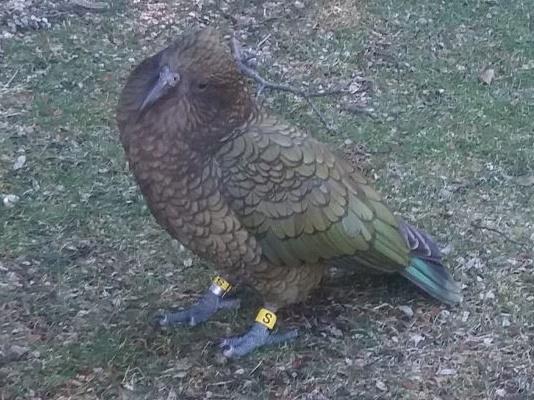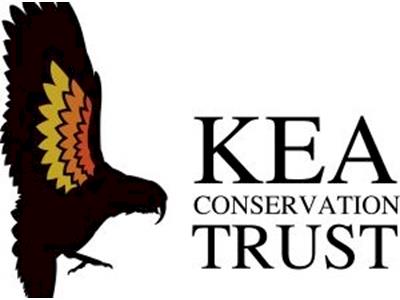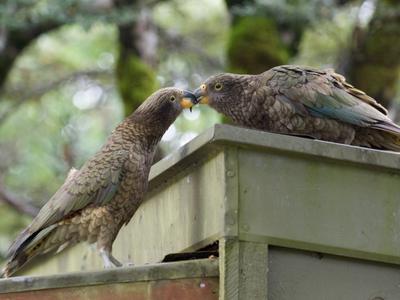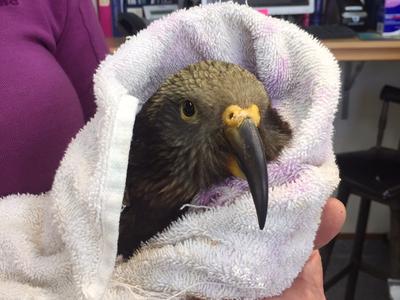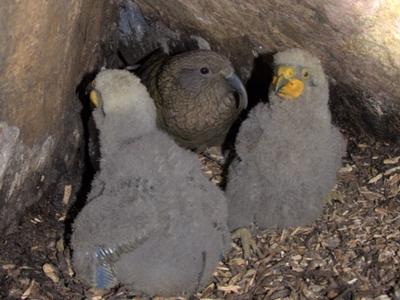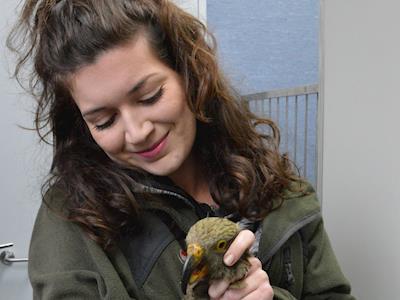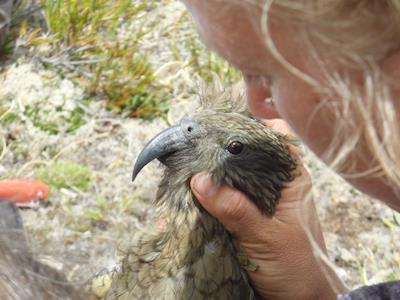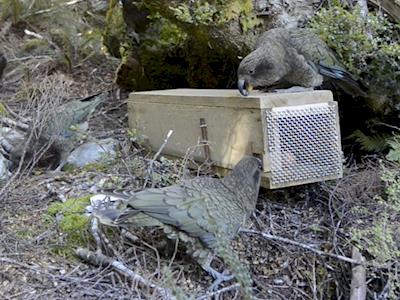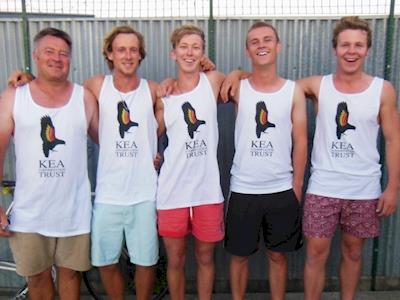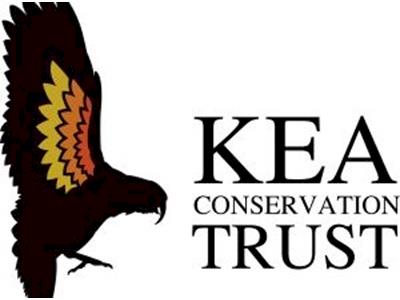The Arthur's Pass kea conservation project.
How can you be actively involved in conservation of a threatened species? Help monitor kea, New Zealand's iconic mountain parrot.
Canterbury
Photo: Douglas, adult male – 5 years old (Black S on Yellow). Sighted at picnic tables opposite Arthur’s Pass Visitors Centre.
BRIEF OVERVIEW
Kea in Arthur’s Pass are not doing so well and we need your help to help them.
We plan to band as many of our native alpine parrot as possible in and around Arthur’s Pass and ski fields in the area. This will give us information on the population and help us develop ways to better protect them. And it will also give great info on every kea, available to everyone via a display board, fact sheet and online . So, if you are lucky enough to get meet a kea while you’re in the area, you’ll be able to record where and when you saw it, along with other details, and learn more about your new buddy!
We’ll also be working to educate locals and visitors because currently kea populations are dwindling due to predators, and sadly, all too often due to human influences. So we want to help people learn how best to help kea so they have the best chance of surviving long into the future.
DETAILED PROPOSAL
The Arthur’s Pass area is the global mecca for seeing kea, our unique alpine parrot, attracting thousands of New Zealand and international tourists each year specifically to see this clever bird. Kea frequent the village, the Store, the main street as well as popular lookout areas such as Death’s Corner and Candy’s bend and of course the local ski fields at Arthur’s Pass and along the adjacent Craigieburn Range. There is growing concern that kea numbers in Arthur’s Pass, and the South Island more generally, are declining and facing ever-increasing threats from human-related activity, as well as from predators. Arthur’s Pass village and surrounds (lookout areas, ski fields, huts) provides an excellent opportunity for kea advocacy and education – some of which has already been undertaken by the Kea Conservation Trust (KCT), Arthur’s Pass Wildlife Trust (APWT) and DOC. There is significant scope to build further on this at Arthur’s Pass, using the very visible kea population to better educate and engage with the public as well as utilising citizen science to undertake ongoing population monitoring. This proposal outlines a plan of action on how we can provide people with a better understanding of kea while also encouraging visitors to partake in kea population monitoring through citizen science - ultimately contributing towards enhanced conservation of kea. Specifically we propose a three part programme involving:
1. A concerted kea banding programme to build up the number of kea that are banded in the greater Arthur’s Pass area (for monitoring and educational purposes)
2. Development of kea advocacy/educational material for new information display boards, a pamphlet fact sheet and a website and mobile phone App so that visitors can learn more about kea in general, and about the specific individuals that visit the Arthur’s Pass area
3. Establishing a system to capture kea monitoring information from the public and incorporation into the national kea database
Kea are an iconic feature of the Arthur’s Pass village and surrounding areas including ski fields (Porter Heights and the club fields along the Craigieburn Range, Mt Hutt and Temple Basin), referred to hereafter as Arthur’s Pass. Without kea this small mountain village in the heart of the Southern Alps would feel empty and the ski fields would lose their character. Long-term residents have already expressed concern that local kea numbers are dwindling. There is significant conflict between kea and humans at Arthur’s Pass, representing a more widespread issue throughout the South Island. Huge growth in visitor numbers continues and with this, more people are feeding and interacting with kea. Signs are present at the village warning people not to feed kea but locals report that these are largely ineffective, with visitors keen to interact and have a close encounter with these curious birds.
What if visitors could be encouraged to have a more positive interaction with kea – one that could benefit both people and kea? We propose that by better educating and engaging visitors they could be part of helping save this Nationally Endangered bird in the longer term. By providing better information about kea through increasing the information provided at Arthur’s Pass and offering people the chance to be part of kea population monitoring, visitors will have a more personal kea experience.
What we are proposing is that visitors will have the unique opportunity to get to know individual kea and their particular personalities by having access to the band combinations of all kea in the area and information about each bird. It is a well-known phenomenon that when a bird is banded, it is instantly recognised as being special, rare or endangered. We propose to band as many kea as possible in and around Arthur’s Pass and ski fields in the area (an ongoing task) and make information on every kea (band colours/combinations, facts about that particular bird, etc) available through three main methods: a large display board, an information pamphlet/fact sheet and a mobile phone App and/or website. These will make each person’s experience with kea a much more personal one. When they see a banded bird they can check which bird it is (much easier with the newer plastic colour bands), and report their sightings. Details could include (for example, but not limited to): where the kea was sighted, date, time of day, behaviour (e.g. feeding, resting, preening, interacting with another kea - or human/non-natural object), or other information such as whether the kea was injured or healthy. Information will be provided to teach people how to read bands and report back to the database. What makes citizen science work, where it does, is the feeling that the people involved have actually ‘done’ something, and this is more effective when it is more than a report “I saw a kea”, but I saw X kea at Y location”- they have contributed because they have learned and feel good about that.
This information can then be sent into a database through a feedback form to be dropped off into a box (at for example DOC VC, the Store, ski field lodge) or posted or emailed back to us, or preferably sent directly from the App or website. The pamphlets could be made available at all the tourist attractions at the Pass (Store, Wobbly Kea, Motels, Education Centre, ski fields etc). The phone App or web page is likely to engage more of the visitors and will allow the user to directly upload data. They would allow a user to select the band combo of the kea seen, where it was sighted (or use the phone’s GPS to get the exact location), upload a photo and other relevant information, which would then go straight to the database.
This project will not only allow visitors to engage with kea on a more personal level but also usefully contribute to the longer term monitoring of this kea population (citizen science). It would be interesting if there were reports of kea that have been banded elsewhere for other studies (e.g. Hawdon birds banded in the KCT population surveys or Otira/Deception kea banded during the DOC 1080 study). This could serve as a pilot study for other locations where kea congregate, e.g. ski fields in the Remarkables, Franz Joseph, etc. If this project is successful then a similar approach could be used in these other areas and contribute to a greater awareness of kea while allowing for a citizen science contribution to local population monitoring. This will be an excellent community-led initiative in partnership with the Kea Conservation Trust, DOC, the local community, researchers and of course visitors.
BUILDING UP THE POPULATION OF BANDED KEA
The initial part of this project would aim to band all of the kea that are present at Arthur’s Pass and surrounding ski fields (Porter Heights, Cheeseman, Broken River, Craigieburn, Temple basin and Mt Hutt). Weights and measurements would be taken at the time of banding and added to the national kea database for use by DOC, the KCT and other researchers. Banding would be carried out by Laura Young, Mark Brabyn, and other people with banding experience under the supervision of Corey Mosen and the KCT. This is the first priority for the project, as a significant proportion of the population needs to be banded before the rest of the project can take place.
EDUCATIONAL DISPLAY
A covered display at one or more suitable sites in Arthur’s Pass and maybe ski fields will be built. Pamphlets (see below) would be available and a box for depositing sighting slips would be set up. The display would cover similar information as in the pamphlet but could also show up to date results of the project. On the display board would be information about kea, e.g. natural history, conservation, their bleak past (the bounty on kea), threats to kea, etc., as well as looking to the future for kea. The next section would say “How can you help?” There we have the details of this project, perhaps a mugshot/photo of some or all of the banded kea (depending how many are banded) etc. KCT, DOC, UC kea researchers and AP community and others would work together to determine the information that goes on the display (and pamphlet).
An additional idea could be to put a big cross through a kea when it dies stating the cause of death if known (e.g. Raphael – Black X on red: hit by car, or Tina – Yellow B on Blue: large quantities of plastic and rubber in guts, lead poisoning etc). This would bring the sad but true reality to visitors that human activity can directly cause kea deaths and people will relate to this – further helping them realise why they shouldn’t feed kea (this was discussed in much detail at the AP community meeting led by the KCT). This would also be updated on the website.
INFORMATION PAMPHLET
A pamphlet outlining the purpose of the project and kea conservation research in the area would be produced and available to the public. Names and colour codes of bands of kea would be listed. The public would then be able to fill in a form, email (or use the website) documenting their sightings of kea and related info (where, when, photo, etc). They would be encouraged to give their email address to join the KCT and be emailed regular updates on the project. A portion of the pamphlet would instruct people how to behave around kea and reasons why we do not feed kea. It could also encourage people to ask others to stop feeding kea. Visitors could even fill out these forms if they are tramping elsewhere in APNP (e.g. the Hawdon or Goat Pass) or the ski fields and see a banded kea. Pamphlets could be kept in huts for visitors to take.
ONLINE SIGHTING FORM
A mobile phone friendly website (and potentially eventually a mobile phone App) will be developed and information would be able to be uploaded by users and sent directly into the local kea database. Web-based information can be updated more easily than pamphlets. This is a great option because of the widespread use of smartphones and the fact that Arthur’s Pass and some ski fields have good cellular coverage available. If the village were to host a free wifi hotspot then information about kea, the project and link to an App or website to upload sightings could appear on the homepage. This could potentially go on to include other areas with banded kea in the future.
LOGISTICS AND PROJECT MANAGEMENT
Implementation of this project will be an ongoing task – with volunteers like Laura, Mark etc making regular visits to Arthur’s Pass to band the kea population until there are enough birds for the display/pamphlet/website information. Some birds there are already banded. This information would be extremely valuable for obtaining a better idea of how many different individuals are coming and going from Arthur’s Pass and surrounding areas, how often and when, where they are sighted and so on. The display board, pamphlet and website information should be updated every year or two (depending on the local recruitment each year).
BUDGET (5 year timeframe)
Cost of Outside Covered Display $30,000
Pamphlets $ 5,000
Website development $ 3,000
Fuel vouchers for kea volunteers $ 1,500
Equipment (bands, catch gear etc) $ 1,000
Advocacy bird teaching resources $ 1,000
Accommodation provided by DOC
ONGOING RESEARCH
A banded kea population is also valuable as a resource to researchers at universities or other institutions, enabling long-term studies to be undertaken. They could have access to the data collected from the project and also contribute towards it.
PARALLEL KEA IN SCHOOLS PROJECT
A proposal to train a kea from Willowbank to visit schools is being looked into by Mark Brabyn. If this proposal is successful, schools visited for this could be encouraged to visit Arthur’s Pass (and possibly stay at the Outdoor Education Centre) and do their own environmental/behavioural studies on the banded kea population.
TIMELINE
August 2016 (onwards)
Banding and photographing Arthur’s Pass Kea
Approach sponsors
Design information pamphlet and display board
Develop web information
Determine display site
Build display
Kea Conservation Trust's involvement (page creator)
Laura Young and Mark Brabyn are the initiators of this project and are both volunteers working with the Kea Conservation Trust.
After completing a MSc in Zoology in 1990 researching Whale Strandings around New Zealand, Mark travelled overseas volunteering on wildlife projects in Canada (Killer whales at Johnson’s Strait), Alaska (Moose and Bald Eagles) and Uganda (Elephants and Chimpanzees). On returning to New Zealand he set up and ran Hiking New Zealand for 20 years. The company won New Zealand Tourism Awards in 2000 (Service to the Environment), 2001 (Best Adventure Operator), 2002 (Best Eco-tourism Operator and Distinction Award). Hiking New Zealand established a wildlife research fund and donated over $80,000 to the conservation of Hector’s dolphin. Mark has also been involved with research on Southern Right whale in Auckland Islands (1996) and Humpback whales in Tonga (1995/96) and since 2011 a volunteer with kea catching and monitoring at Okarito, Deception, Hawdon and Aspiring. In 2014 Mark achieved a distinction for his Postgraduate Certificate in Antarctic Studies.
Laura has always had a passion for kea, but also for the New Zealand forest and mountains in general. She a strong interest in and broad research background in the ecology and conservation of native biodiversity. After working in ecology both in NZ and overseas, Laura completed her PhD in 2012 investigating the role kea play in the ecosystem, specifically seed dispersal of alpine plants (along with other animals, native and introduced). She enjoys sharing scientific research with the public and has given many talks at ecological conferences as well as community groups, and written popular articles for the wider community about particular aspects of kea research among other topics. Laura has worked both as a volunteer and as an experienced bird handler for the Kea Conservation Trust and DOC for seven years and has banded >40 kea, has considerable experience with catching, banding, attaching transmitters and taking blood samples from kea. Laura also studied kea feeding behaviour and diet analysis for her own research and for working for other researchers.
About us
The Kea Conservation Trust was set up in 2006 to assist in conservation of wild Kea (Nestor notabilis) in their natural habitat and to increase the husbandry standards and advocacy potential of those Kea held in captive facilities within New Zealand.
Other page links
Latest update
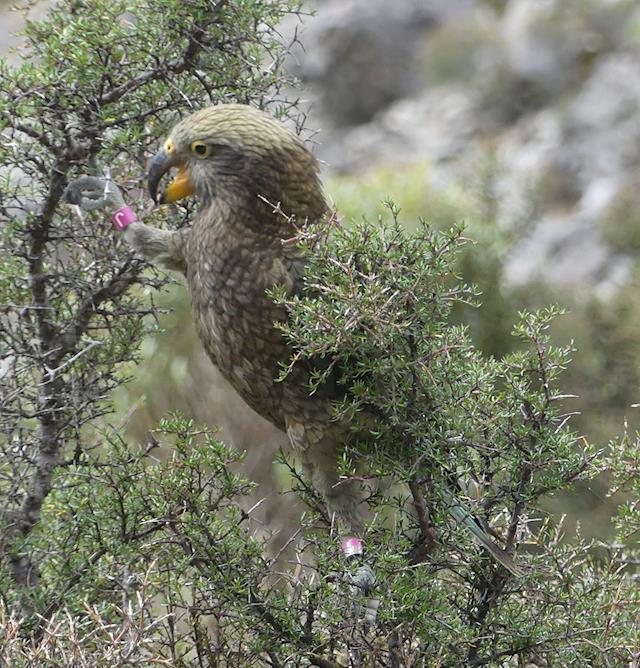
A final thank you for Arthur's Pass kea conservation 30 March 2018
We have achieved most of our major goals for kea conservation at Arthur's Pass! This has been possible thanks to you wonderful folks who donated to our kea conservation/ citizen science project on givealittle over the past year and a half.
Over the past year we have built a very large shelter packed with information all about kea (aka the "Kea Kiosk") in the heart of Arthur's Pass village, kea country. This is visited by sometimes hundreds of people per day!
We have also achieved some great advocacy and educational work too. Thousands of people have already been involved in looking for kea, recording sightings onto the online database, helping educate others why we should never feed kea, understanding the extent of the lead poisoning issues in the area and making good progress towards removing some of the sources of this lead from the environment, and much more.
We've banded more than 50 kea over the past year, received 1300 sightings within the first 7 months of launching the online kea sightings database, received hundreds of photos of banded kea and there's been great interest and uptake from people in sponsoring kea (and naming them), further contributing funding towards this project.
We have learned so much already through creating this citizen science initiative. By encouraging so many people to record their kea sightings, particularly of banded birds, we have been able to document just how many "new" kea are showing up in the main Arthur's Pass area, which ones stay around and which disperse elsewhere, receive sightings of older kea (some of which were banded more than ten years ago), determine how old some wild kea are, track individuals who are sick or injured, take them to the vet for treatment and upon release the more people looking, the more likely it is that these kea are spotted again. For example, two of the five kea taken to the amazing team at the South Island Wildlife Hospital in Christchurch last year for treatment of lead poisoning were recently spotted, clarifying that they're still alive and okay. Having a portion of this population with unique leg bands on is very useful for learning about kea ecology and behaviour, especially where there are so many people out there looking and recording. We have managed to distribute brochures and sightings forms to dozens of back country huts and sightings are coming in from all over the South Island.
The logical next step for us is to have some kea banded in other key areas where kea and humans interact (e.g. Milford road, Fiordland). People form a real connection with the animals when they read up about individual kea with profiles on the sightings database website and love seeing how many times a bird that they enjoy following is recorded on the map.
We've done numerous talks to schools, tramping clubs and other clubs and organisations and encouraged so many people to get out there and have a go looking for, and recording kea. We've received excellent feedback and listen to the suggestions people send us with ideas to make this project even better.
We truly appreciate and value your support and hope that you will get out there looking for kea (and all other nature too!)
Nga mihi nui,
The Arthur's Pass Kea Sightings team
Latest donations


Thanks so much for your support. We spend a fair bit of time in the area around Hawdon Hut, monitoring nests and banding new birds. It's a great spot.



Who's involved?
Our other pages
Page Q&A
Ask a question hereAny concerns?
Report this pageThank the donor
Your message will be displayed on the page and emailed to the donor.
Your new message will also be emailed to the donor.
Saving a blank entry will delete the current comment.

